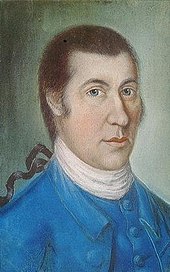Samuel McIntire
Samuel McIntire (born January 16, 1757 in Salem , Province of Massachusetts Bay , † February 6, 1811 , ibid) was an American architect and artist.
Born in Salem in what is now Massachusetts , he began his career as a carver and wood sculptor . After his marriage to Elizabeth Field on October 10, 1778, he built a simple house with an attached workshop on Summer Street, which was completed in 1786.
From the beginning of the 1780s, McIntire began working as an architect for the merchant Elias Hasket Derby , for which he appropriated the Palladianism then preferred from books . After a short time he was known in New England as a builder of elegant homes. In 1792 he submitted a design for the construction of the Capitol in Washington, DC . From around 1795 he increasingly adopted the Federal Style for his designs , which architects such as Charles Bulfinch had derived from Georgian architecture as a special American expression .
All of McIntire's public buildings were in Salem, and most of the homes he designed were in the state of Massachusetts. Together with his brothers Joseph and Angier, he founded a company in 1799 that carried out his designs; In addition to the houses, Samuel also designed essential parts of the decoration and supervised their execution.
Typical of McIntire's designs are the room layout with four smaller rooms around a central, larger hall and the three-storey construction.
Samuel McIntire was also famous as a wood sculptor, and his busts of Voltaire and John Winthrop are now owned by the American Antiquarian Society in Worcester, Massachusetts.
Web link
- Samuel McIntire at salemweb.com (English)
| personal data | |
|---|---|
| SURNAME | McIntire, Samuel |
| BRIEF DESCRIPTION | American architect and sculptor |
| DATE OF BIRTH | January 16, 1757 |
| PLACE OF BIRTH | Salem , Massachusetts |
| DATE OF DEATH | February 6, 1811 |
| Place of death | Salem , Massachusetts |
